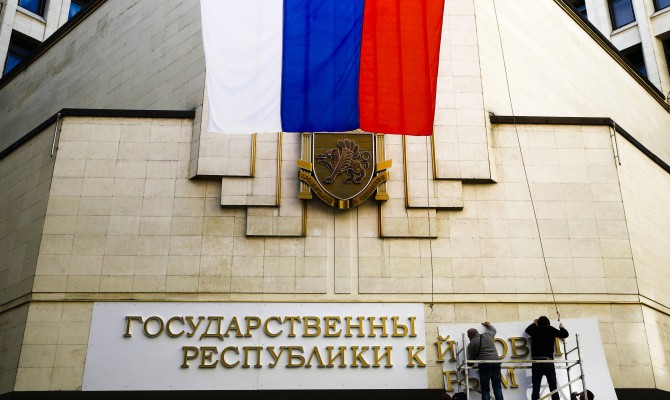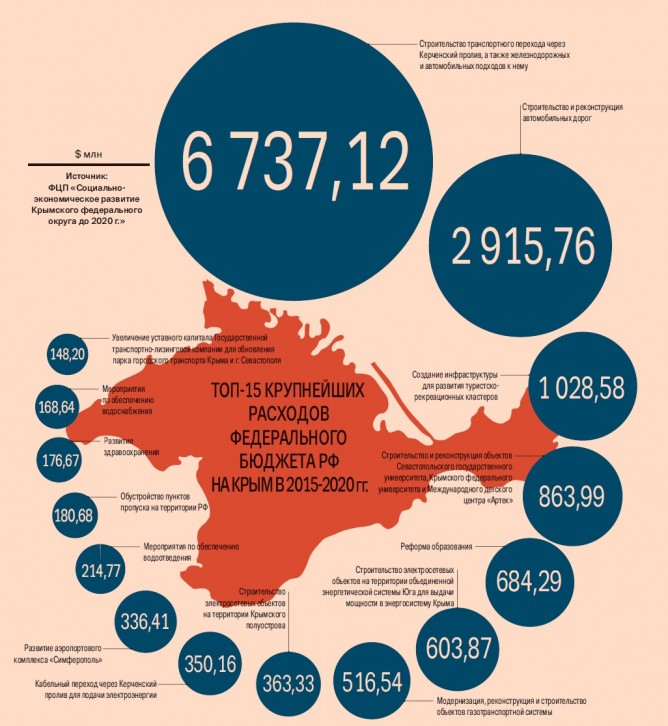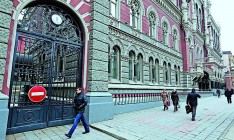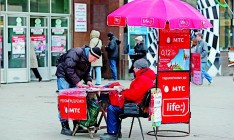Economy
regionsIn 2015 Russia will spend US $9.9 bn on development and other needs of Crimea

On September 18, the Russian government approved the draft of the federal budget for 2015 and the indices for 2016–2017, where it found a place and money for restoration of the annexed Crimea. For these purposes the three-year national draft budget, which the government of Russian Prime Minister Dmitry Medvedev intends to submit to the State Duma in October, provides 379.8 bn rubles, approximately US $9.9 bn at the current exchange rate, including 377.8 bn rubles (US $9.8 bn) next year. For comparison: subsidies and subventions from the Ukrainian state budget for the needs of the peninsula in 2013 amounted to a mere UAH 4.4 bn (approximately US $327 mn).
The lion’s share of expenditures from the federal budget in 2015 will be spent on development of the transport infrastructure, which will connect the peninsula, which is currently cut off from Russia, with the Krasnodar Region. Moscow will also have to pay a handful of money for recovery of the energy and water supply systems in the region, which is still receiving 80–85% of its fresh water and 80% of its electricity from mainland Ukraine. The government will meet these and other challenges, mainly in infrastructure, through the targeted program Social and Economic Development of the Crimean Federal District by 2020 (FTP), approved by the Russian government on August 11. Its ultimate funding is RUR 681.2 bn (U.S. $17.7 bn) for six years. More than half of this amount (up to RUR 373 bn or U.S. $9.7 bn) should be allocated over the next three years, according to the draft budget.
Connection with the mainland
The attempt to build an overland passage to Crimea will be the most expensive project for Moscow. At the moment, Russians can get to the peninsula bypassing Ukraine only by ferry passage. Russian President Vladimir Putin plans to change the situation with the construction of a bridge across the Kerch Strait. Last autumn the construction of such a bridge was a joint project between Kyiv and Moscow. The two sides resumed talks after a two-year hiatus in November 2013. However, at that time the cost of the entire project, from the development of the design to the completion of construction, was estimated at US $2.5–3 bn. It was assumed that both states would finance the project in equal shares, but the money was not to be taken from the budgets of the two countries, rather from private investors.
Since then, however, the project’s cost estimate increased significantly. Today, construction of the 19 km long Kerch passage, which will include a 4-lane road for vehicles and two railway tracks, will alone require RUR 246.9 bn (US $6.4 bn), according to the FTP. This amount will not be financed by private investors, but will be entirely at the expense of the federal budget.
Construction of railways and roads leading to the bridge will require another RUR 12.2 bn (US $317 mn) from the budget. “Approaches to the bridge - coastal, transport, railway, automobile infrastructure both on the sides of the Taman and Kerch peninsulas – are very expensive,” said Russian Vice Premier Dmitry Kozak, commenting on the doubled cost of the project.
The idea proposed by Russian Ambassador to Ukraine Mikhail Zurabov in the summer of 2013 was the only thing that did not change in the project of the transport crossing – the bridge will have not only roads and railways, but also a power line to meet the needs of Crimea. The only difference is that now it is not a hypothetical possibility, but the need for the annexed peninsula. The Russian government plans to spend RUR 13.5 bn (US $350 mn) on laying of a cable across the Kerch Strait to supply electricity to Crimea. In addition, another RUR 23.5 bn (US $611 mn) will be spent on construction of an electric grid complex on the other side of the strait – in the Krasnodar Region - to supply electricity to the peninsula.
As it appears from the statement of Russia’s Minister of Transport Maksim Sokolov, construction of the transport crossing already began in August, but Russians and Crimeans will not be able to use it any time soon. The first section of the bridge, which will consist of railroad tracks and a highway (one lane in each direction), will be completed in December 2018. It is expected that the entire transport passage will be completed in 2020.
Interfax reported that construction of the bridge will be entrusted to the Stroitransgaz Group of companies controlled by Russian businessman Gennady Timchenko and the Mosotrest company owned by Arkady and Boris Rotenberg will be one of the sub-contractors.
To their own detriment
In order to find resources to support Crimea the Russian government had to seek additional sources of revenues, which is not easy in conditions of increasingly tough sanctions from the West and the threat of economic recession. Last week the European Bank of Reconstruction and Development downgraded its forecast of the Russian economy in 2015 to a 0.2% decline, even though in May it expected that it would grow by 0.6%. Experts of the international organization believe the sanctions imposed by the EU and the U.S. against Russia will weaken business confidence, restricting access of companies and banks to international capital markets and will reduce private investments. Household savings for unexpected needs will increase, which will adversely affect consumption. Foreign trade will suffer as well, because exporting companies will need time to restore the existing trade relations or redirect sales from western countries to the east and Latin America.
Nevertheless, the Russian government was forced to increase expenditures of the federal budget in 2015 compared to those provided in the national budget for 2014 by RUR 1.675 trillion (US $43.6 bn) – up to RUR 15.4382 trillion (US $401.4 bn), and the fifth part of the amount of the increase will be spent on restoration of Crimea.
At the same time, an increase in revenues of the federal treasury by RUR 960 bn (US $25 bn) – up to RUR 15.0524 trillion (US $391.4 bn) is planned. The government decided to obtain additional funds by limitation of social spending, which is to the detriment of Russians. In particular, a decision was made to extend freezing of citizens’ pension savings for 2015. As a result of the moratorium on the funded element of pensions, the state will save RUR 309 bn (US $8 bn), according to Finance Minister Anton Siluanov. Cancelation of fixed payments to insurance pensions will save the budget another RUR 30.5 bn (US $793 mn). Russians were expecting to receive them since the beginning of next year. Yet these funds will be used not only for the needs of Crimea. Some of the amount will be allocated to the anti-crisis reserve, which among other purposes will be used to support major companies in the fuel and energy and financial sectors, according to Siluanov. The project also provides for the rejection of the 2% increase in pensions for military veterans. This will help save RUR 19.2 bn (US $499 mn) in 2015.
Civil servants will be a source of savings in addition to the retirees. Siluanov’s ministry proposes to limit an increase in the number of civil servants, making an exception only for those who will be required to implement the Crimean FTP. The agency also plans to abandon indexation of salaries of federal officials next year and change the terms and indicators of raising wages for social workers and scientists.
Finally, the last measure which should bring RUR 20 bn (US $520 mn) to the state treasury, will affect all Russians without exception. The government intends to receive this amount from additional revenues from customs duties on e-commerce as a result of the reduction of the maximum limit for duty-free import of goods ordered by Russians abroad via the Internet to EUR 150 and weighing less than 10 kg.
Medvedev intends to use corporate sources for filling the budget, although not as vigorously as in the social sphere. For example, RUR 100 bn (US $2.6 bn) should be provided by privatization of the 19.5% stake in the state-owned Rosneft approved in July. Another RUR 41.7 bn (US $1.1 bn) of proceeds is expected from levying an excise duty on gas exports to Turkey via the Blue Stream.
Moreover, the national budget approved by the government of the Russian Federation for 2015 is unlikely to be the final version, even if it is passed by the parliament. In particular, the draft law envisages introduction of changes to the document in the event that more financing is required for the Crimean FTP.







 of the agreement of syndication with Financial Times Limited are strictly prohibited. Use of materials which refers to France-Presse, Reuters, Interfax-Ukraine, Ukrainian News, UNIAN agencies is strictly prohibited. Materials marked
of the agreement of syndication with Financial Times Limited are strictly prohibited. Use of materials which refers to France-Presse, Reuters, Interfax-Ukraine, Ukrainian News, UNIAN agencies is strictly prohibited. Materials marked  are published as advertisements.
are published as advertisements.